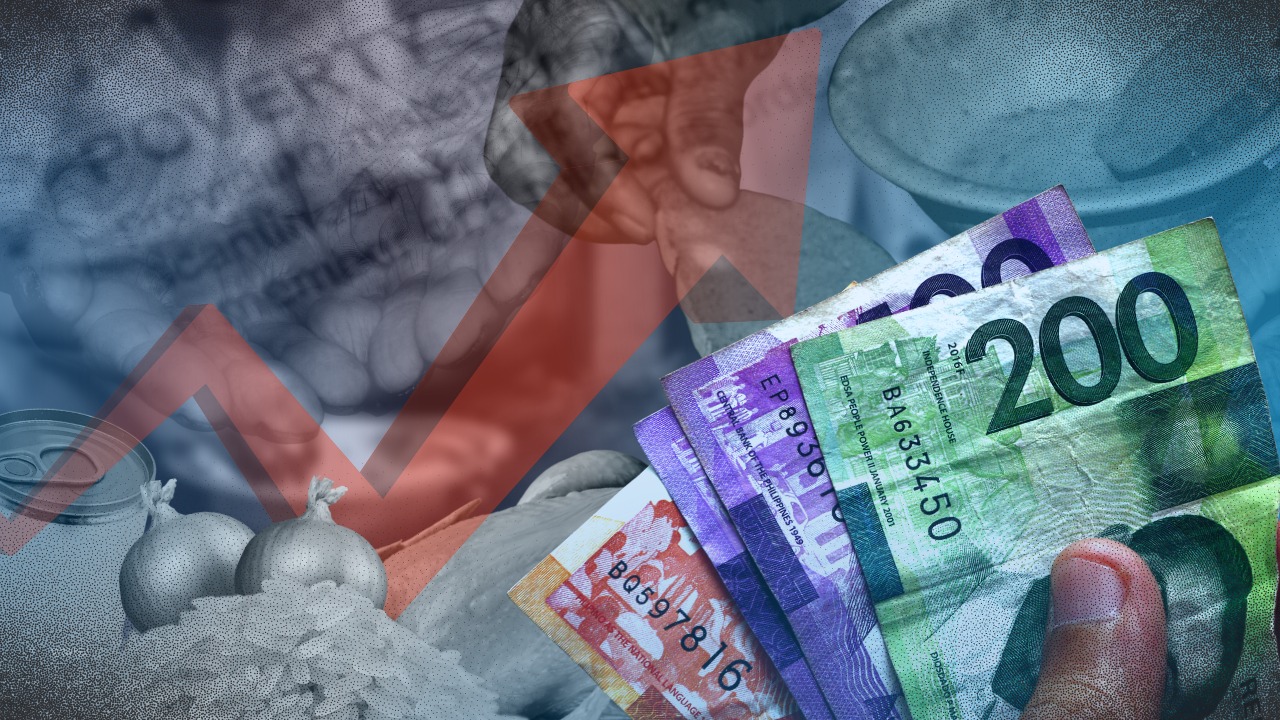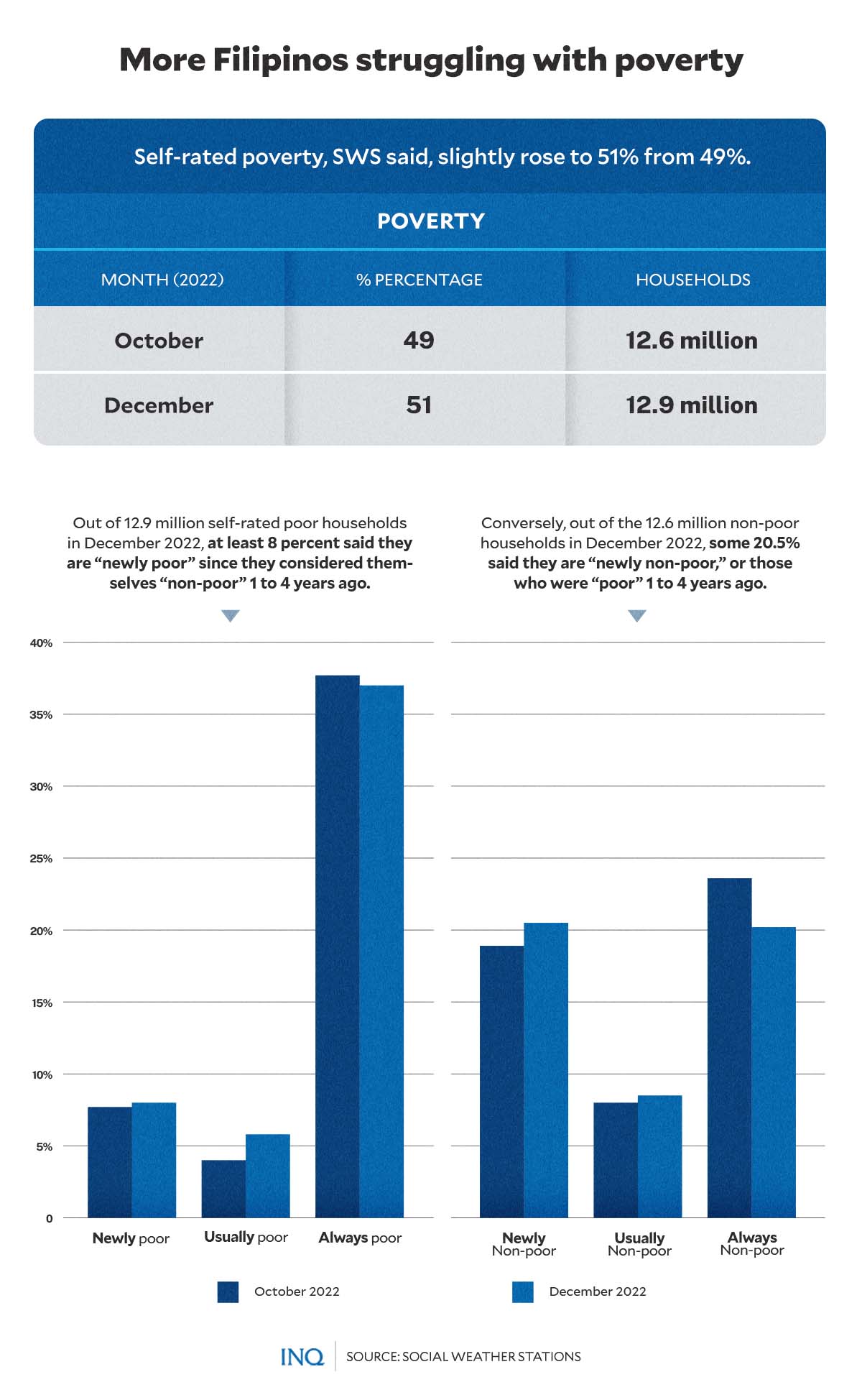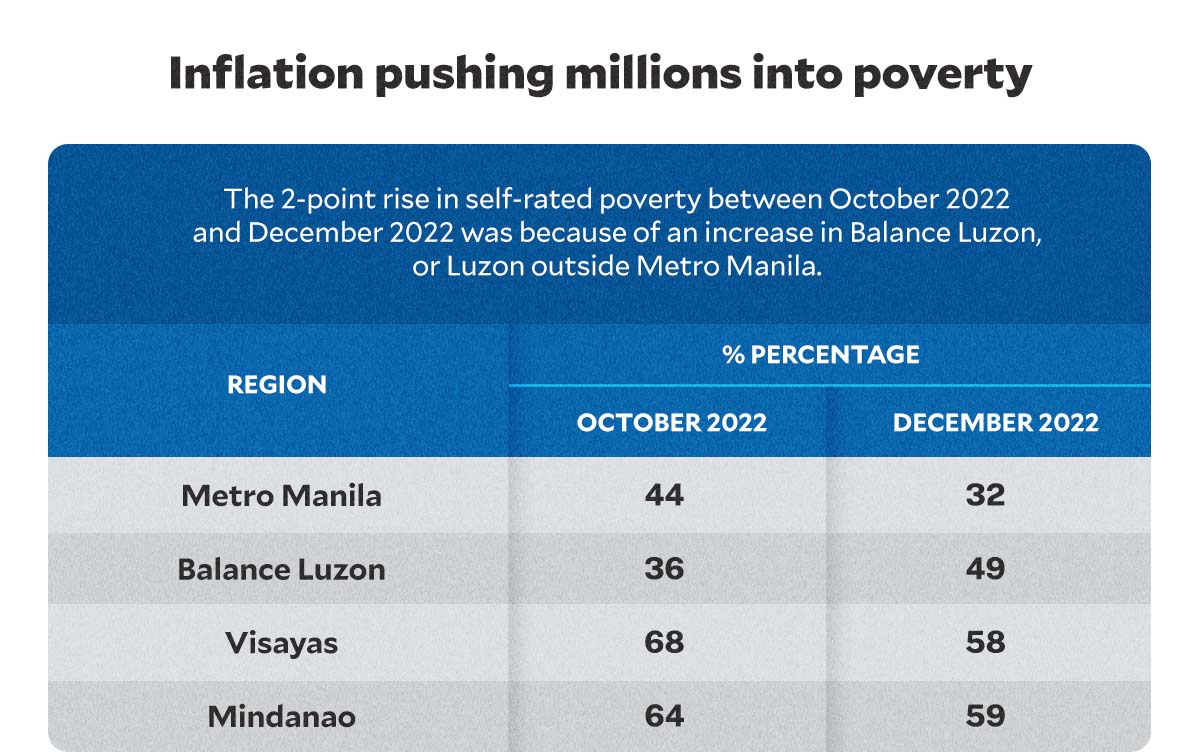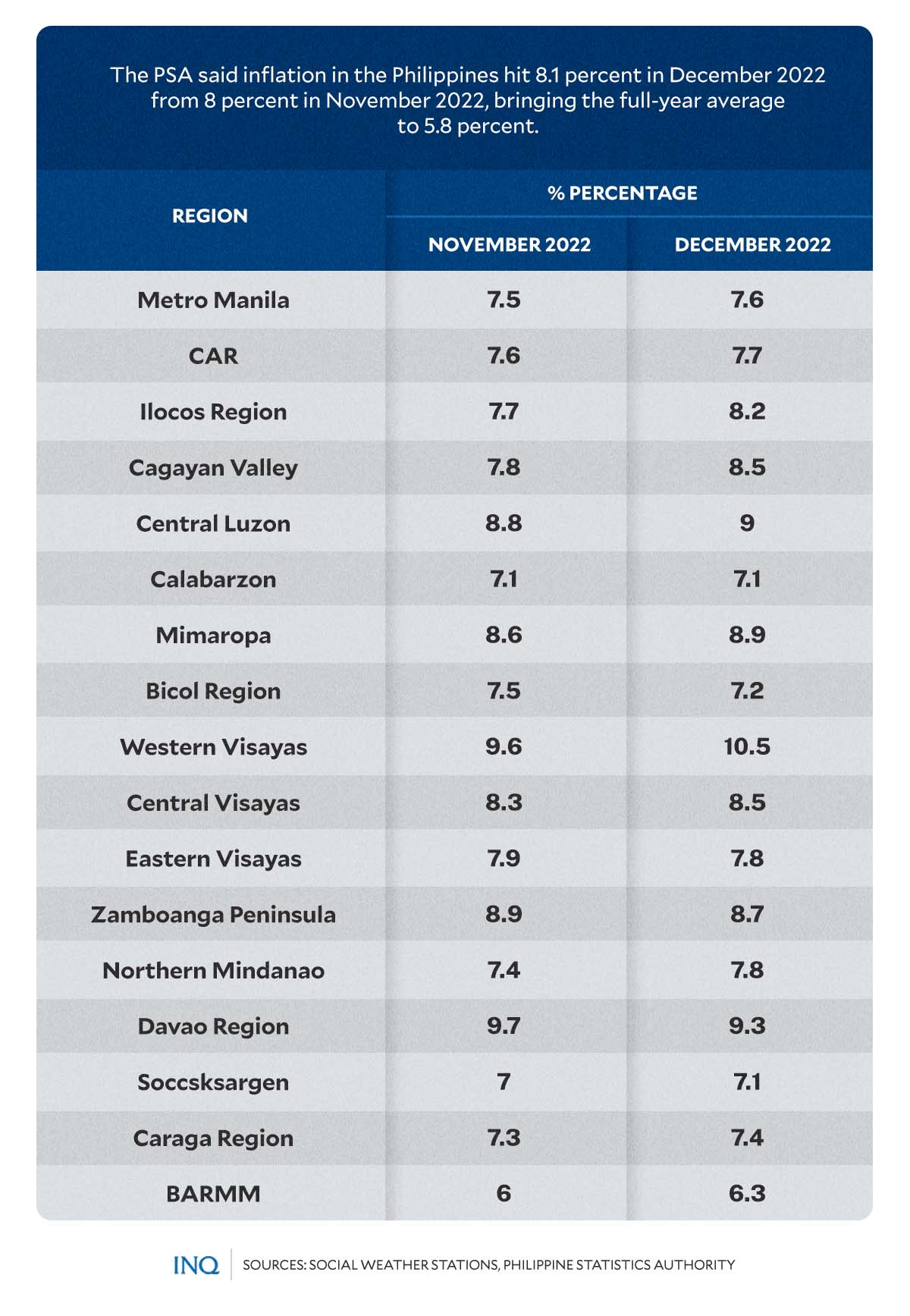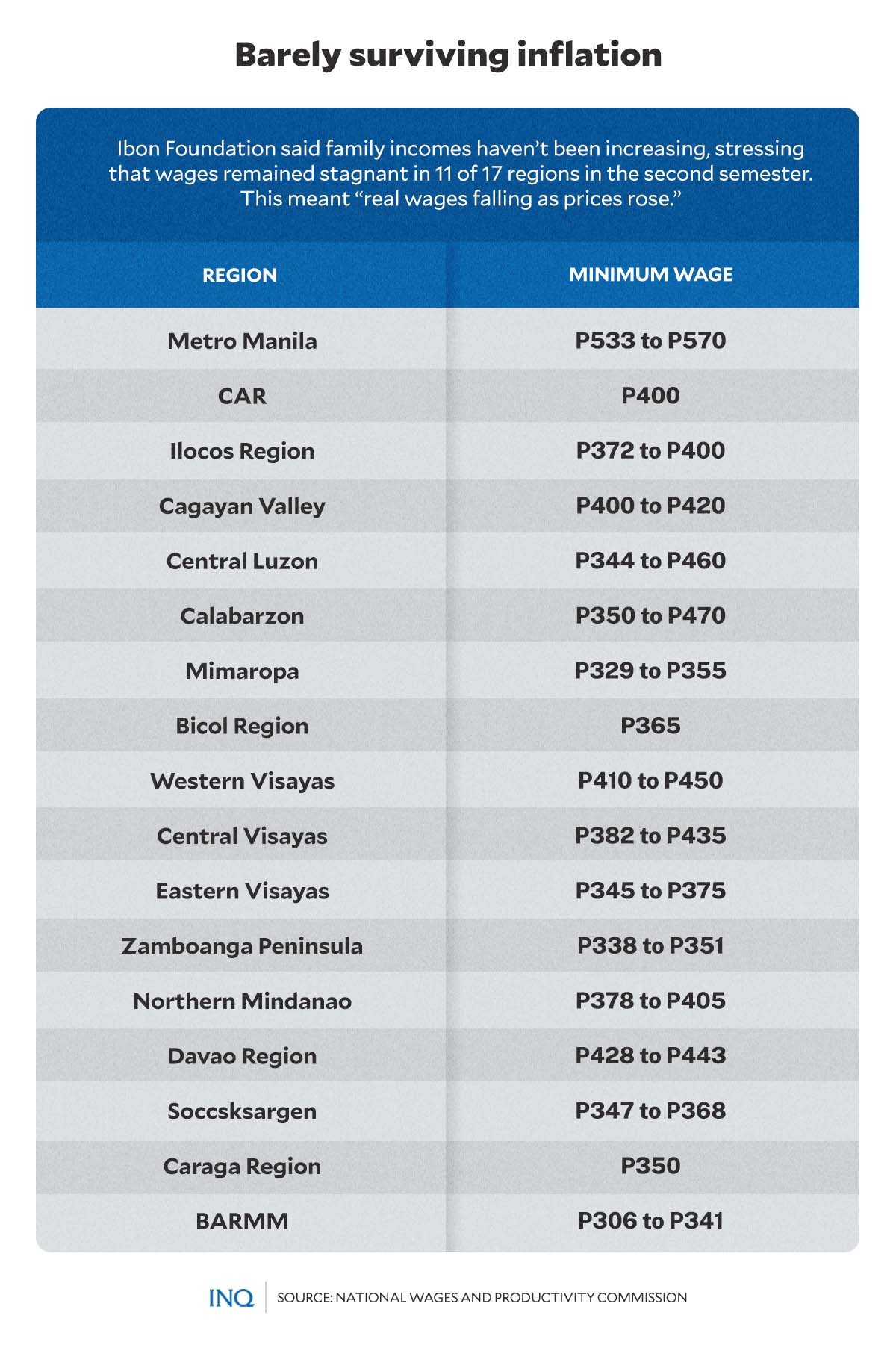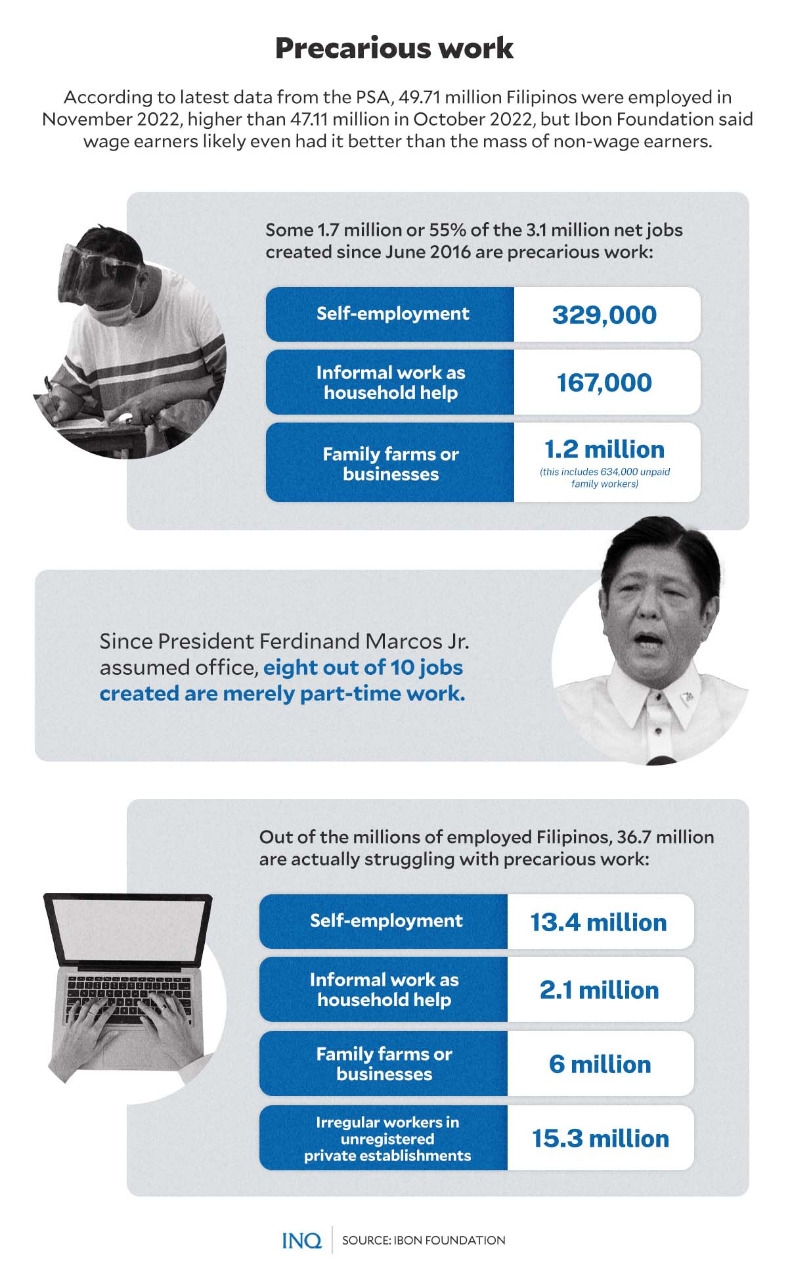2M non-poor households hit by inflation, rate selves poor now
MANILA, Philippines—As inflation accelerated to a 14-year high last month, more Filipino families considered themselves poor, with some two million newly poor, or those who were non-poor one to four years ago.
But why?
Sonny Africa, executive director of the think tank Ibon Foundation, explained that “poverty is a function of family incomes and prices of basic goods and services,” but “unfortunately, there have been adverse trends in both in the last part of the year since Ferdinand Marcos Jr. took office.”
He told INQUIRER.net on Tuesday (Jan. 17) that “except for a very incremental slowdown in August 2022, inflation was accelerating throughout the second semester from 6.1 percent in June 2022 to 8.1 percent in December 2022.”
According to the Philippine Statistics Authority (PSA), the spike in the readout last month was mainly because of the higher annual increase in the price index of food and non-alcoholic beverages at 8.4 percent from 8.2 percent in the previous month.
Article continues after this advertisementWith high inflation, Africa, an economist, said “families will definitely fall into poverty when their incomes are unable to keep up with rising prices and they see their consumption and welfare collapse.”
Article continues after this advertisementBased on latest data from the Social Weather Stations (SWS), which conducted a survey on self-rated poverty on Dec. 10 to 14, 2022, the number of poor families slightly rose to 12.9 million (51 percent) from October’s 12.6 million (49 percent).
READ: More PH families rate themselves as ‘poor’
Some 31 percent rated themselves as borderline or placed themselves on a horizontal line dividing the poor and not poor, higher than 29 percent in October, while 19 percent considered themselves not poor, down from 21 percent.
Out of the 12.9 million self-rated poor households last month, some eight percent said they were newly poor, higher than 7.7 percent in October, when inflation hit 7.7 percent because of price gains in key commodity groups such as food and non-alcoholic beverages.
SWS said 1.5 million (5.8 percent) were usually poor or those who were non-poor five or more years ago, up from October’s 1 million, and 9.4 million (37 percent) were always poor or those who never experienced being non-poor, slightly down from 9.6 million.
Conversely, out of the 12.6 million non-poor households last month, some 20.5 percent, or 5.2 million households, said they were newly non-poor, or those who were poor one to four years ago. Some 2.2 million were usually non-poor, while 5.2 million were always non-poor.
As explained by the SWS, the self-rated poverty threshold, or the minimum monthly budget self-rated poor families say they need for home expenses in order not to consider themselves poor, which was P15,000 in December, has remained sluggish for several years despite considerable inflation.
“This indicates that poor families have been lowering their living standards, i.e., belt-tightening,” it said.
Poverty hitting Luzon
According to SWS, the rise in self-rated poverty last month was because of the increase in rates in Balance Luzon, or Luzon outside Metro Manila, combined with decreases in Metro Manila, the Visayas, and Mindanao.
Compared to October 2022, self-rated poor rose in Balance Luzon from 36 percent to 49 percent. However, it fell in Metro Manila from 44 percent to 32 percent, in the Visayas from 68 percent to 58 percent, and in Mindanao from 64 percent to 59 percent.
Looking at data from the PSA, most regions in Luzon registered a higher readout, with Bicol being the only region with a lower inflation rate—7.5 percent in November and 7.2 percent in December. The readout in Calabarzon stayed at 7.1 percent.
Inflation was 7.7 percent from 7.6 percent in the Cordillera Administrative Region, 8.2 percent from 7.7 percent in Ilocos Region, 8.5 percent from 7.8 percent in Cagayan Valley, 9 percent from 8.8 percent in Central Luzon, and 8.9 percent from 8.6 percent in Mimaropa.
READ: Philippines inflation near 14-year high; more rate hikes seen
Then in Western Visayas, the readout accelerated to 10.5 percent from 9.6 percent. Inflation was likewise higher at 8.5 percent from 8.3 percent in Central Visayas, but lower in Eastern Visayas—7.8 percent from 7.9 percent.
Davao Region registered a 9.3 percent inflation rate, down from 9.7 percent, but the rest of the regions in Mindanao had higher price gains—7.1 percent from 7 percent in Soccsksargen and 7.4 percent from 7.3 percent in Caraga Region.
The Bangsamoro Autonomous Region in Muslim Mindanao (BARMM) had an inflation rate of 6.3 percent in December 2022, higher than the previous month’s 6 percent, the PSA said last Jan. 5.
Barely keeping up with inflation
But despite the readout accelerating to a 14-year high, Ibon Foundation said “family incomes really haven’t been increasing” and this is the problem, especially when “prices are not just rising but rising very rapidly.”
READ: Philippine inflation rose further to 8.1% in December
Africa shared as an example the nominal wages that remained stagnant in 11 of 17 regions in the Philippines in the second semester of 2022. He said this meant “real wages falling as prices rose.”
“Where wages were hiked—Ilocos Region, Calabarzon, Bicol Region, Northern Mindanao, Soccsksargen, and BARMM—the increase just averaged 5.9 percent which barely kept up with inflation for the whole year.”
Based on data from the National Wages and Productivity Commission (NWPC), Metro Manila has the highest minimum wage at P533 to P570, but the Ibon Foundation said last month’s readout had already pushed the living wage for a family of five to P1,146 nationwide.
The think tank said the average nominal wage of P404 all over the Philippines is just one-third or 35.3 percent of the nationwide family living wage, while in Metro Manila, the P570 only translates to 49.8 percent of the wage that a family of five needs to live decently.
BARMM has the lowest minimum wage at P306 to P341. Next are Mimaropa (P329 to P355), Caraga Region (P350), Zamboanga Peninsula (P338 to P351), Soccsksargen (P347 to P368), and Bicol Region (P365).
Most jobs created not enough
Also a problem, Africa said, is that some 1.7 million or 55 percent of the 3.1 million net jobs created since June last year are in precarious self-employment (329,000) or other informal work as household help (167,000) or family farms or businesses (1.2 million), including 634,000 categorized as unpaid family workers.
“Still, wage earners likely even had it better than the mass of non-wage earners,” he said.
According to Africa, since Marcos Jr. assumed office, eight out of 10, or 79.3 percent, of jobs created are in mere part-time work.
Ibon Foundation estimated that some 36.7 million or three-fourths (74 percent) of those reported as employed are actually struggling with precarious self-employment (13.4 million) or other informal work as household help (2.1 million), in family farms or businesses (6 million), or irregular workers in unregistered private establishments (about 15.3 million).
“The two million newly poor almost certainly draw from this huge mass of Filipinos that are in poor quality work and perhaps also some who lost their livelihoods for one reason or the other,” he said.
